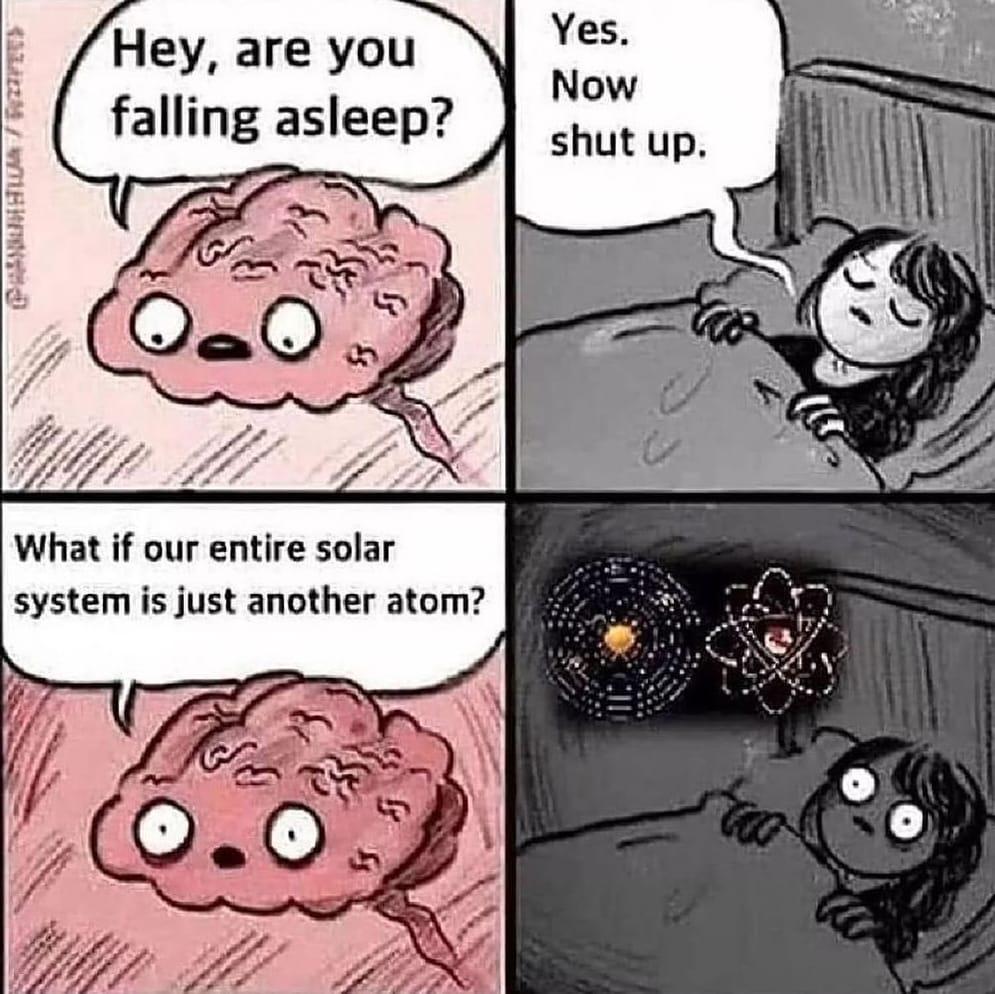this post was submitted on 03 May 2024
456 points (90.7% liked)
Science Memes
11631 readers
2303 users here now
Welcome to c/science_memes @ Mander.xyz!
A place for majestic STEMLORD peacocking, as well as memes about the realities of working in a lab.

Rules
- Don't throw mud. Behave like an intellectual and remember the human.
- Keep it rooted (on topic).
- No spam.
- Infographics welcome, get schooled.
This is a science community. We use the Dawkins definition of meme.
Research Committee
Other Mander Communities
Science and Research
Biology and Life Sciences
- [email protected]
- [email protected]
- [email protected]
- [email protected]
- [email protected]
- [email protected]
- [email protected]
- [email protected]
- [email protected]
- [email protected]
- [email protected]
- [email protected]
- [email protected]
- [email protected]
- [email protected]
- [email protected]
- [email protected]
- [email protected]
- [email protected]
- [email protected]
- [email protected]
- [email protected]
- [email protected]
- [email protected]
- !reptiles and [email protected]
Physical Sciences
- [email protected]
- [email protected]
- [email protected]
- [email protected]
- [email protected]
- [email protected]
- [email protected]
- [email protected]
- [email protected]
Humanities and Social Sciences
Practical and Applied Sciences
- !exercise-and [email protected]
- [email protected]
- !self [email protected]
- [email protected]
- [email protected]
- [email protected]
Memes
Miscellaneous
founded 2 years ago
MODERATORS
you are viewing a single comment's thread
view the rest of the comments
view the rest of the comments

General relativity is famously difficult to understand, and I don't claim to fully understand it, so I'm going to fall back to the famous rubber sheet model.
Imagine the Earth in empty space. The mass of the Earth causes spacetime curvature that extends outward away from the Earth. However, if you look a single little patch of spacetime at some distance, say, 1000 km away, that little patch doesn't know that it has to be curved because the Earth is 1000 km away. It doesn't know where the Earth is. It just knows that its neighboring patch is a little bit more curved in the direction that leads to Earth, and its other neighbor is a little bit less curved going away from Earth. This essentially restates the principle of locality: all physics is local physics, and there is no spooky action at a distance.
Now imagine that the Earth moves by some small distance dx in a small time dt. Going back to our little patch of spacetime, it doesn't know that the Earth moved. So how does it change its curvature to match the new position of the Earth? It changes when its neighbors change. When the Earth moves, the spacetime immediately near the Earth stretches and bends first, then spacetime a little further away, and so on and so on. This process doesn't happen instantaneously; it takes time for changes to propagate to longer distances. The theory predicts that disturbances and ripples will propagate via waves, called gravitational waves, and that these waves travel at the same speed of light as electromagnetic waves.
Notice I called these spacetime waves "gravitational waves." It is common to use the term "gravity waves" for typical water waves, of the kind you might see at the beach. Those are not the same type of wave.
Now let's talk about energy. The Earth in the solar system has some energy, including translational and rotational kinetic energy, gravitational potential energy as it sits in the Sun's gravity well, and of course its own thermal energy and rest mass. Waves have the ability to transport energy from one location to another without transporting matter, mass, or electric charge. Spacetime waves are not any different. Because the Earth is moving in a periodic motion, it produces a periodic spacetime wave that propagates outward away from the solar system, and that spacetime wave carries some amount of energy away from the solar system. Where does that energy come from? It comes from the Earth, mainly from the Earth's kinetic energy.
So the story is that the gravitational waves are very, very, very slightly causing the Earth to slow down in its orbit. And following the laws of orbital mechanics, this causes the Earth to fall closer to the Sun. The result is that over the long term, the radius of the Earth's orbit gets smaller. Alternatively, the Earth's circular orbit is an illusion, and it's actually spiraling inward on a very, very, tightly packed spiral. That's what I meant by "orbital decay."
I find it hard to overstate just how small this gravitational radiation effect is for a typical solar system situation. We have an observatory called LIGO that can detect gravitational waves. It can measure a variation in distance of a tunnel of several kilometers down to well less than a single proton diameter. (Remember, this is trying to detect disturbances in space and time itself). Even still, it is only able to detect gravitational waves from the most powerful kinds of gravitational events--mergers of black holes and the like.
Essentially: Spacetime is very "stiff" and gravity is very weak.
That was a great read, thank you
Thank you very much for the thought out explanation, i think im beginning to grasp the concept. To summarize to make sure:
So the comparison to atoms releasing EM energy is a bit more apt then I initially thought. Thanks again!